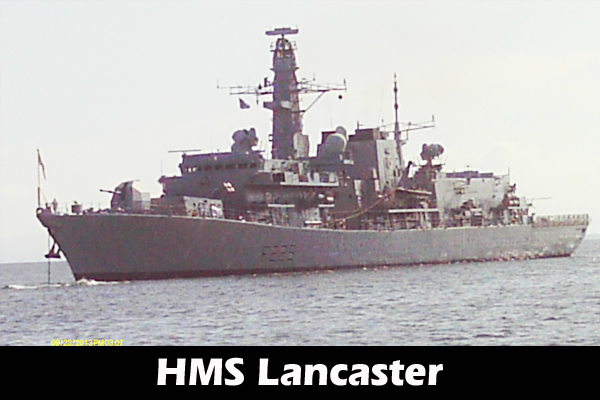The interior of a warship is something that civilians usually do not get the opportunity to see. Today, however, members of the media and special invited guests were taken on a complete familiarization tour of a 432-foot modern British frigate warship, equipped with all the contemporary gadgetry and fittings, including a helicopter. The medium-sized naval vessel is making rounds in the Caribbean as part of a regional anti-drug operation launched by the Joint Interagency Task Force South (JIATF), a US-based multiservice task force, which coordinates regional initiatives to suppress the flow of sea-bound illicit trafficking operations.
A little after midday today, the group was taken on a fifteen-minute trip from the jetty in front of EuroCaribe on Fort Street to the present location of the vessel, which is approximately 5.7 nautical miles off the coast of Belize City.
The H.M.S. Lancaster, which is also known as The Queen’s Frigate, sits like a towering giant in the waters off Belize’s coast, weighs 4,900 tonnes and houses a 190-member crew. The tour commenced with a visit to the Control Room, where a 5-man crew is stationed to monitor the status of the ship’s equipment around the clock. The crew oversees the operations in the ship’s interior and also conducts reconnaissance in the nearby waters using highly advanced technological apparatus.
The personnel of the five-floor war craft operate some of the most modern sensors and weapons systems in the Royal Navy. The Warfare Branch comprises three groups; Weapons, Sensors and Communications. The Weapons group operates a vertical launch missile system together with a Harpoon anti-ship missile (used against enemy ships) and the 4.5″ Mod 1 gun (used to support onshore troops using naval gunfire). The Sensors group is responsible for optimizing the use of the highly sensitive sonar, radar and electronic warfare equipment to form a composite picture that is used to indicate the position of the enemy to the weapons systems, and the Communications group operates the sets that maintain tactical interactions, as well as ensure connectivity with shore headquarters.
Lieutenant Commander Adrian Gubby, one of the chief weapons engineers, told Amandala that they have been in the Caribbean for six and a half months and their purpose, in spite of all the warship’s capabilities, is mainly to provide humanitarian relief in the case of any natural disaster, to conduct counter-narcotics operations, and to ensure the overall wellbeing of the Caribbean Commonwealth countries. He stated that the frigate and its crew are here in Belize to reassure the members of the Commonwealth that they are here to assist them, because they (The Royal Navy) try as much as possible to support their Commonwealth counterparts. Gubby also mentioned that the ship’s crew is made up of 180 members of the British Royal Navy along with 10 members of the US Coast Guard.
The Operations Room, also known as the Warfare Nerve Center, is where information from the sensors is displayed. The captain, his principal warfare officers, and the Command team can see exactly where friendly and enemy units are deployed. From there, the captain then assesses the threat posed to the ship, or the force of the ships which the H.M.S. Lancaster may be helping to defend. The ship’s design incorporates many stealth features. These make the ship a difficult target for an enemy to find, but if it was to come under attack, there are several self-defense weapons which could be used. Most notable is the Vertical Launch Seawolf missile system, which engages aircraft and missile targets. Other self-defense systems include the use of cruise missiles and torpedo decoys.
The ship is also able to deploy two types of helicopters, depending on the mission. H.M.S. Lancaster can also be tasked in wartime to use its long-range Harpoon missile against enemy ships or to provide bombardment in the form of naval gunfire support to shore troops using the 4.5″ Mod 1Gun, a canon-like British naval gun.
Although the ship is outfitted with torpedoes, mounted machine guns and depth charges for varied forms of warfare, the ship’s role in peacetime is equally important, whether it is providing relief to victims of natural disaster, evacuating citizens from potentially hostile countries, or simply giving support for British interests abroad. While that is the role that it is playing at this time, they are here primarily to curb narco-trafficking activities on the high seas of the Caribbean.
The ship and its crew, as mentioned earlier, are part of a multi-agency unit which undertakes counter-illicit trafficking operations in this region. They left the United Kingdom in May of this year, and will be in the Caribbean until November 13th, when they are scheduled to return home. The tour was facilitated by the British High Commission in Belize.

